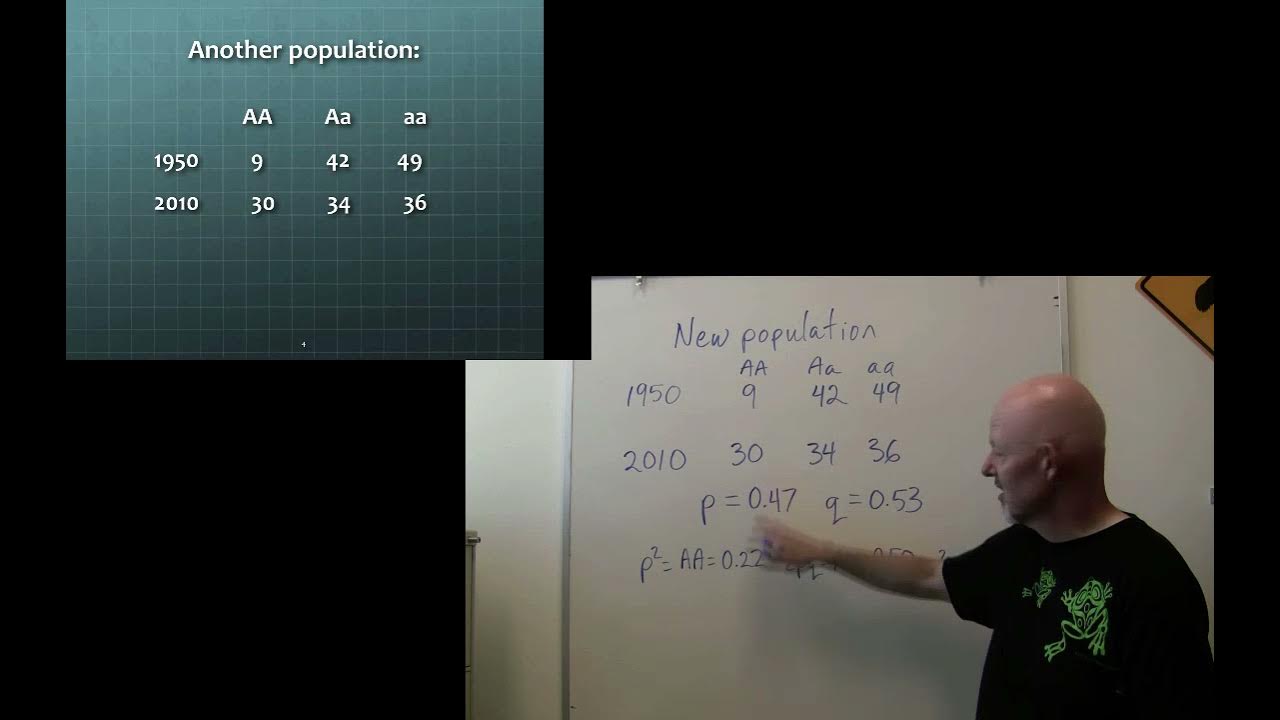Hukum Hardy & Weinberg
Summary
TLDRThis video explains Hardy-Weinberg's law, which states that gene frequencies in a population remain stable unless specific conditions, such as mutation, migration, random mating, population size, and natural selection, are disrupted. Using an example of a population with albinism, the presenter demonstrates how to calculate carrier and homozygous normal gene frequencies, applying Hardy-Weinberg equations to estimate percentages. The explanation emphasizes the significance of the formula, with a focus on understanding how genetic traits are passed down in a population. The video concludes with a note that the same principles apply to X-linked traits, to be covered in future content.
Takeaways
- 😀 Hardy-Weinberg's law explains that allele frequencies in a population will remain constant under certain conditions.
- 😀 Key conditions for Hardy-Weinberg equilibrium include no mutation, random mating, no large-scale migration, a large population size, and no natural selection.
- 😀 The Hardy-Weinberg equation is represented as p² + 2pq + q² = 1, where p and q represent allele frequencies of two alleles.
- 😀 P² represents the frequency of homozygous dominant individuals, 2pq represents heterozygous individuals, and q² represents homozygous recessive individuals.
- 😀 The example in the script involves albinism, a recessive genetic disorder represented by the allele 'a'.
- 😀 Individuals with albinism are homozygous recessive (aa), while carriers are heterozygous (Aa) and normal individuals are homozygous dominant (AA).
- 😀 To calculate the frequency of carriers, we use the formula 2pq, where 'p' is the frequency of the dominant allele and 'q' is the frequency of the recessive allele.
- 😀 In the example, 0.01% of the population has albinism, which is used to calculate the value of 'q'.
- 😀 Using q = 0.01, we find p = 0.99. The frequency of carriers (2pq) is then calculated as 0.0198, or 1.98%.
- 😀 The frequency of homozygous dominant (normal) individuals is calculated as p² = 0.99², which equals 98.01%.
Q & A
What is the Hardy-Weinberg law?
-The Hardy-Weinberg law is a mathematical model in population genetics that describes how allele frequencies in a population remain constant from one generation to the next, under ideal conditions.
Who were the key figures behind the Hardy-Weinberg law?
-The Hardy-Weinberg law is named after two key figures: G. H. Hardy, an English mathematician, and Wilhelm Weinberg, a German physician.
What are the five conditions necessary for Hardy-Weinberg equilibrium?
-The five conditions for Hardy-Weinberg equilibrium are: 1) No mutation, 2) Random mating, 3) No large-scale migration, 4) A large population size, and 5) No natural selection.
What is the general equation for the Hardy-Weinberg principle?
-The general equation for the Hardy-Weinberg equilibrium is: P² + 2PQ + Q² = 1, where P is the frequency of the dominant allele and Q is the frequency of the recessive allele.
What do the terms P², 2PQ, and Q² represent in the Hardy-Weinberg equation?
-In the Hardy-Weinberg equation: P² represents the frequency of homozygous dominant individuals (AA), 2PQ represents the frequency of heterozygous individuals (Aa), and Q² represents the frequency of homozygous recessive individuals (aa).
How is the Hardy-Weinberg principle used in population genetics?
-The Hardy-Weinberg principle is used to calculate the frequency of alleles and genotypes in a population, assuming no evolutionary forces are acting on the population.
In the example from the transcript, what genetic condition was used to explain Hardy-Weinberg's law?
-In the example, albinism, a recessive genetic condition, was used to explain how to calculate allele frequencies and carrier rates in a population.
How is the carrier frequency (heterozygous individuals) calculated in the Hardy-Weinberg example?
-The carrier frequency is calculated using the equation 2PQ, where P is the frequency of the dominant allele and Q is the frequency of the recessive allele. In the example, it was found to be 1.98%.
What is the importance of the Hardy-Weinberg equilibrium in genetics?
-The Hardy-Weinberg equilibrium provides a baseline for studying genetic variation in populations and helps identify when evolutionary forces like mutation, migration, or natural selection are affecting the population.
How is the Hardy-Weinberg equilibrium affected by real-world factors like mutation or migration?
-In real-world populations, factors such as mutation, migration, and natural selection often disrupt the Hardy-Weinberg equilibrium, leading to changes in allele frequencies over generations.
Outlines

This section is available to paid users only. Please upgrade to access this part.
Upgrade NowMindmap

This section is available to paid users only. Please upgrade to access this part.
Upgrade NowKeywords

This section is available to paid users only. Please upgrade to access this part.
Upgrade NowHighlights

This section is available to paid users only. Please upgrade to access this part.
Upgrade NowTranscripts

This section is available to paid users only. Please upgrade to access this part.
Upgrade NowBrowse More Related Video

110 Allele and Genotype Frequencies

Genetics Step 1 — Hardy-Weinberg Law — Boards and Beyond

Frekuensi gen dalam populasi ( Hukum Hardy Weinberg )

110 Hardy Weinberg Equilibrium

Discussions of conditions for Hardy Weinberg | Biology | Khan Academy

Population Genetics: When Darwin Met Mendel - Crash Course Biology #18
5.0 / 5 (0 votes)